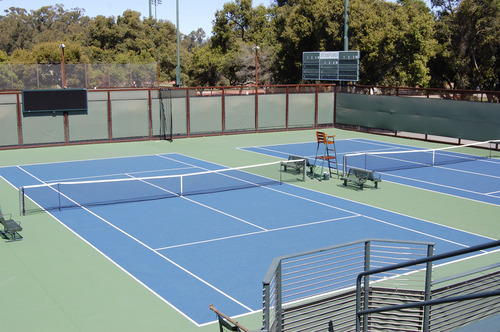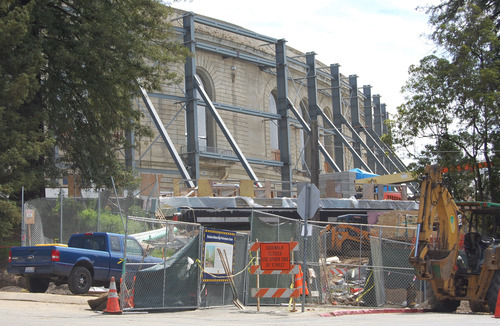This is an archived article that was published on sltrib.com in 2011, and information in the article may be outdated. It is provided only for personal research purposes and may not be reprinted.
For the Utah Utes, moving into the Pac-12 Conference is a bit like moving into a modest fixer-upper on a block full of wealthy neighbors.
While the Utes are fixing the fence, the neighbors are remodeling their kitchen. Tidy the yard? Somebody else is building a deck. And just as the Utes are proudly patching their driveway, those rich folks down the street are putting in a pool.
"It's an arms race, unfortunately, in college athletics," athletic director Pat Haden of USC says.
Perhaps nowhere is that more obvious than the campuses of the Pac-12, where seemingly every school is in the midst of one massive capital project or another, designed to improve the facilities that attract top recruits and dazzle the paying customers. The Trojans are building a $70 million football headquarters at the center of campus, for example, and Cal is spending $321 million on a renovation of historic Memorial Stadium.
Meanwhile, the UCLA Bruins are renovating hallowed Pauley Pavilion for $136 million, the Arizona Wildcats are embarking on a plan to spend $378 million in facilities upgrades in the next two decades, and Oregon State is planning to build a track, a boathouse and an academic center, after already investing heavily in the last decade just to get off the mat against its richer rivals.
Oh, and don't even ask about Oregon, whose partnership with billionaire entrepreneur Phil Knight and his Nike shoe company has yielded state-of-the-art facilities so famously luxurious — from plasma screens and video games in the football locker room to underwater treadmills in the training center — that they have enjoyed their own feature article in Sports Illustrated magazine.
"Our facility infrastructure has been key to our success," athletic director Rob Mullens said.
Indeed, it has been said that without Knight, the Ducks would simply be the Beavers — paddling along in relatively remote outposts in the Pacific Northwest, mostly struggling to keep up with their sun-splashed neighbors.
And though increased investment in facilities and infrastructure is no guarantee of success — most schools use a combination of private donations and loans to pay for their projects — the Utes know they cannot afford to lag behind if they expect to compete for the top prizes.
Not when athletes such as Cal's Marvin Jones acknowledge that facilities can play a huge role in the decision-making process of top prospects.
The senior football player who led the Golden Bears in receiving the past two seasons entertained offers from all of the schools in the Pac-12, and visited Oregon before choosing Cal because it was closer to home and felt more comfortable. He acknowledged that the facilities at Oregon "definitely blew me away" and said he believes he is rare in looking beyond the flash of a ritzy locker room.
"I don't think a lot of guys are like that," he said. "They tend to go to the schools that wow them."
Thus, the lust for athletic cathedrals.
Already, the Utes have taken their first step toward joining the club by unveiling plans for an expansion of their Dee Glen Smith Center football complex on Guardsman Way that will cost at least $16 million — all of it from private donors, school officials said. Football coach Kyle Whittingham pointedly said the current facility is not one of the "excellent football facilities" the Utes enjoy, while athletic director Chris Hill agreed the team needs more sizzle to compete.
"It's a matter of 'Are you big-time or are you not?' " he said when plans were announced. "Recruits come to campus and say, 'Oh, this is not that great. This is not what it is at school X.' We want to make sure we take that off the table to help us recruit. Otherwise, it puts us in a disadvantage."
The irony, of course, is that it's impossible to ever really win that battle — which is being waged all over the country, from the Pac-12 to the Big Ten to the SEC.
While the Trojans are "going to have all the bells and whistles" in their new football facility, Haden acknowledged that "somebody is going to break ground in six months and have more bells and whistles than us. And then somebody else is going to break ground … you're sort of chasing your tail a little bit."
For the moment, the Utes are focused mostly on just improving the areas that need attention, rather than trying to outspend anybody — something they can't afford to do, anyway, facing the same economic challenges as other schools but with a smaller fan base from which to draw donations.
The Utes have a few top priorities, Hill said, beyond the new football headquarters.
Most importantly, perhaps, they need a new softball field, with the university planning to build a student recreation center on the site of the current one. Hill said they also need outdoor tennis courts and an improved basketball practice facility — something Colorado and Arizona State recently constructed.
The basketball teams currently practice in the Huntsman Center, with locker rooms near the floor and offices along the ground-level concourse.
"We have to make some front-end investments that we just have to do," Hill said.
On the bright side for the Utes, though, is that not every one of their new rivals has brand-new, top-of-the-line facilities for each sport.
While Stanford (like Oregon) has seemingly limitless resources and world-class facilities for seemingly every sport it offers, the rest of the schools in the Pac-12 are more like the Utes — armed with facilities of varying quality and forced to invest based on their priorities.
Washington has a stunning boathouse on the shore of Lake Washington, for example, reflecting the historical importance of crew there, while Oregon State has built one of the finest baseball complexes in the league.
The Utes are arguably right in the mix with Rice-Eccles Stadium for football and the Huntsman Center for basketball. They also recently built a new track on campus, and enjoy a nice soccer stadium, an impressive academic center and a state-of-the-art gymnastics headquarters — even if the baseball team has to play its home games at Spring Mobile Ballpark, the home of the Triple-A Salt Lake Bees.
"We have a lot of good things," Hill said. "It's not overwhelming what we have to do to compete in everything." —
Five big digs
Schools in the Pac-12 Conference seem to almost always be upgrading their athletic facilities. Here's a look at five of the big ones welcoming the Utah Utes to the league:
Memorial Stadium • The Cal Golden Bears are working on a $321 million renovation of Memorial Stadium, built in 1923. The project will effectively replace everything on the inside of the stadium — from seats, restrooms and concession stands to luxury suites and the press box — while retrofitting it to reduce the risk of catastrophic earthquake damage. The stadium is expected to reopen for the 2013 season, with the Bears playing home games next season at AT&T Park in San Francisco.
Husky Stadium • The Washington Huskies are spending $250 million to renovate Husky Stadium, built in 1920. The project will replace most of the seating, add luxury suites, remove the track encircling the field and construct a football operations building. It should be done for the 2013 season. In the meantime, the Huskies will play their home games — starting with their Apple Cup game against Washington State on Nov. 5 — at CenturyLink Field (formerly Qwest Field) in downtown Seattle.
Pauley Pavilion • After much debate about how to do it, the UCLA Bruins are renovating legendary Pauley Pavilion at a cost of $136 million. The project will upgrade aging infrastructure and spruce up the exterior, modernizing the arena's amenities to include a glass-enclosed concourse, new locker rooms and a luxury club. It's expected to be completed in time for the 2012-13 basketball season; the Bruins will play home games next season at the L.A. Sports Arena and the Honda Center in Anaheim.
Arizona Stadium • The Arizona Wildcats are planning to renovate the north end zone of Arizona Stadium for $72.3 million, as part of a plan to spend $378 million on a dozen projects over the next 20 years. The planned 80,000-square foot facility will include offices, locker rooms, a weight room and training room and a cafeteria, and could be done by the summer of 2013.
McKay Center • Construction is under way on the $70 million John McKay Center at USC, a 110,000-square foot facility that will include an academic center, locker rooms, a weight room, training room and media production facility. It's expected to be done next summer.











